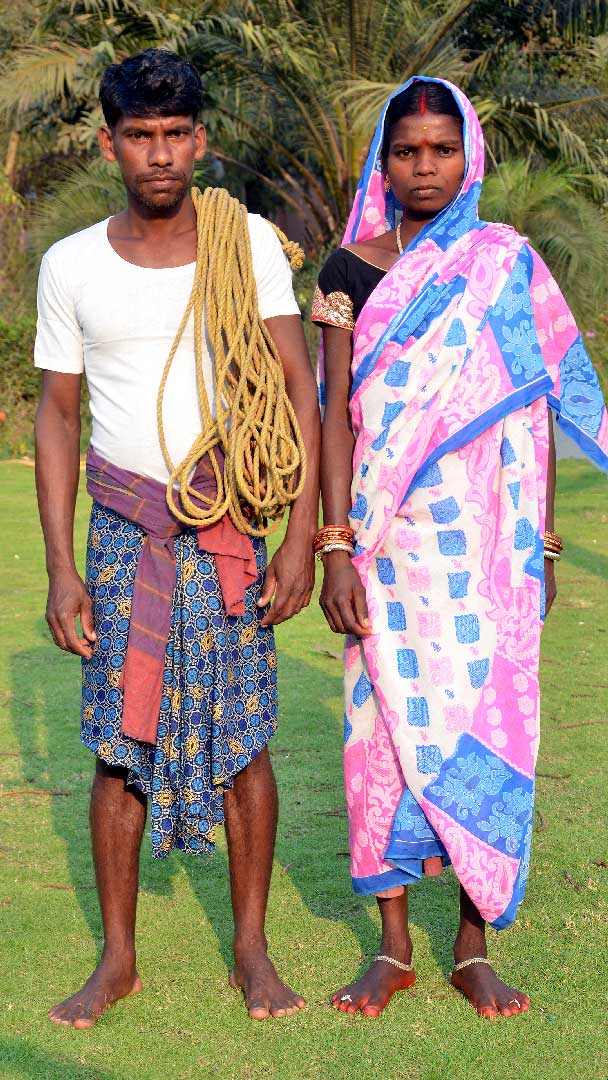TRIBES OF ODISHA
TRIBES OF ODISHA
Lodha
Nodh, Nodha, Lodh
Region: Mayurbhanj and Cuttack
Population*: 3,112
Language: Kudumali, Odia
Map: Click Here
Origin: At one time grouped under the draconian Criminal Tribes Act by the British, the Lodha trace their origins to the Savaras of the Hindu puranas. The name Lodha is derived from the word Lubdhaka meaning trapper.
Occupation: Basically hunter-gatherers they used to rely on the sale of kendu and siali leaf cups and plates, tussar cocoons, resin and honey for a livelihood. Traditionally, breeding of tassar moths and the collection of their cocoons was the main income generating activity of the Lodha. Fish and tortoise are their main game. Shifting and settled agriculture was also practiced and recently many Lodha have engaged in agricultural labor, rope making and construction work besides taking up any small business or work that will earn them money.
*Scheduled Tribes Population as per Census 2011 data.
PVTGs Population as per Micro Project Survey Data, 2010
Lodha
Nodh, Nodha, Lodh
Region: Mayurbhanj and Cuttack
Population*: 3,112
Language: Kudumali, Odia
Map: Click Here
Origin: At one time grouped under the draconian Criminal Tribes Act by the British, the Lodha trace their origins to the Savaras of the Hindu puranas. The name Lodha is derived from the word Lubdhaka meaning trapper.
Occupation: Basically hunter-gatherers they used to rely on the sale of kendu and siali leaf cups and plates, tussar cocoons, resin and honey for a livelihood. Traditionally, breeding of tassar moths and the collection of their cocoons was the main income generating activity of the Lodha. Fish and tortoise are their main game. Shifting and settled agriculture was also practiced and recently many Lodha have engaged in agricultural labor, rope making and construction work besides taking up any small business or work that will earn them money.
*Scheduled Tribes Population as per Census 2011 data.
PVTGs Population as per Micro Project Survey Data, 2010
Lodha
Nodh, Nodha, Lodh
Region: Mayurbhanj and Cuttack
Population*: 3,112
Language: Kudumali, Odia
Map: Click Here
Origin: At one time grouped under the draconian Criminal Tribes Act by the British, the Lodha trace their origins to the Savaras of the Hindu puranas. The name Lodha is derived from the word Lubdhaka meaning trapper.
Occupation: Basically hunter-gatherers they used to rely on the sale of kendu and siali leaf cups and plates, tussar cocoons, resin and honey for a livelihood. Traditionally, breeding of tassar moths and the collection of their cocoons was the main income generating activity of the Lodha. Fish and tortoise are their main game. Shifting and settled agriculture was also practiced and recently many Lodha have engaged in agricultural labor, rope making and construction work besides taking up any small business or work that will earn them money.
*Scheduled Tribes Population as per Census 2011 data.
PVTGs Population as per Micro Project Survey Data, 2010
Lodha
Nodh, Nodha, Lodh
Region: Mayurbhanj and Cuttack
Population*: 3,112
Language: Kudumali, Odia
Map: Click Here
Origin: At one time grouped under the draconian Criminal Tribes Act by the British, the Lodha trace their origins to the Savaras of the Hindu puranas. The name Lodha is derived from the word Lubdhaka meaning trapper.
Occupation: Basically hunter-gatherers they used to rely on the sale of kendu and siali leaf cups and plates, tussar cocoons, resin and honey for a livelihood. Traditionally, breeding of tassar moths and the collection of their cocoons was the main income generating activity of the Lodha. Fish and tortoise are their main game. Shifting and settled agriculture was also practiced and recently many Lodha have engaged in agricultural labor, rope making and construction work besides taking up any small business or work that will earn them money.
*Scheduled Tribes Population as per Census 2011 data.
PVTGs Population as per Micro Project Survey Data, 2010
PVTG Communities
62 Scheduled Tribes
PVTG Communities
62 Scheduled Tribes
PVTG Communities
62 Scheduled Tribes





